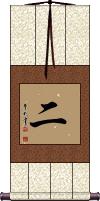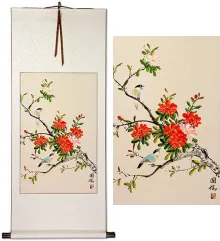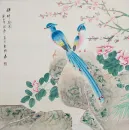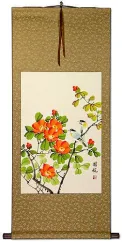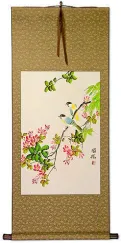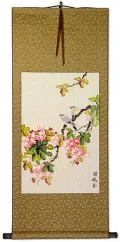Many custom options...
And formats...

The name Number Two in Chinese / Japanese...
Buy a Number Two calligraphy wall scroll here!
Two
The number two
二 is the number 2 in Chinese, Korean Hanja, and Japanese Kanji. I have no idea why you would want this as a calligraphy wall scroll but hundreds of visitors search for this number.
In Japanese, this character can be pronounced several different ways depending on context. It can be ni, aru-, futa-, and a few others when combined with other characters.
There's just one way to pronounce this in Chinese. Korean also has just one pronunciation.
This in-stock artwork might be what you are looking for, and ships right away...
Gallery Price: $178.00
Your Price: $98.88
Gallery Price: $106.00
Your Price: $58.88
Gallery Price: $232.00
Your Price: $128.88
Gallery Price: $268.00
Your Price: $148.88
Not the results for number two that you were looking for?
Below are some entries from our dictionary that may match your number two search...
| Characters If shown, 2nd row is Simp. Chinese |
Pronunciation Romanization |
Simple Dictionary Definition |
來 来 see styles |
lái lai2 lai rai らい |
More info & calligraphy: To Come / To Arrive(female given name) Rai āgama; āgam-; āgata. Come, the coming, future. |
超 see styles |
chāo chao1 ch`ao chao wataru わたる |
More info & calligraphy: Super(prefix) (1) (ちょう only) super-; ultra-; hyper-; extreme; (prefix) (2) (colloquialism) extremely; really; totally; absolutely; (suffix noun) (3) (ちょう only) (after a number or counter) over; more than; (given name) Wataru vikrama. Leap over, surpass; exempt from; to save.; Two ways of passing over (to bliss): 豎 the lengthwise, or long way (of Hīnayāna); and 橫 the crosswise, or short way of Mahāyāna. |
雙 双 see styles |
shuāng shuang1 shuang sō |
More info & calligraphy: ShuangA pair, couple, twin; mates, matched. |
地獄 地狱 see styles |
dì yù di4 yu4 ti yü jigoku じごく |
More info & calligraphy: Hell(1) {Buddh} hell realm; Naraka; (2) {Christn} Hell; (3) hell; misery; nightmare; inferno; (4) place where a volcano or hot springs constantly spew smoke or steam; (place-name) Jigoku naraka, 捺落迦 (or 那落迦) ; niraya 泥犂; explained by 不樂 joyless; 可厭 disgusting, hateful; 苦具, 苦器 means of suffering; if 地獄 earth-prison; 冥府 the shades, or departments of darkness. Earth-prison is generally intp. as hell or the hells; it may also be termed purgatory; one of the six gati or ways of transmigration. The hells are divided into three classes: I. Central, or radical, 根本地獄 consisting of (1) The eight hot hells. These were the original hells of primitive Buddhism, and are supposed to be located umder the southern continent Jambudvīpa 瞻部州, 500 yojanas below the surface. (a) 等活 or 更活 Saṃjīva, rebirth, where after many kinds of suffering a cold wind blows over the soul and returns it to this life as it was before, hence the name 等活. (b) 黑繩 Kaslasūtra, where the sufferer is bound with black chains and chopped or sawn asunder. (c) 線合; 衆合; 堆壓 Saṃghāta, where are multitudes of implements of torture, or the falling of mountains upon the sufferer. (d) 號呌; 呼呼; 叫喚 Raurava, hell of wailing. (e) 大呌; 大號呌; 大呼 Mahāraurava, hell of great wailing. (f) 炎熱; 燒炙 Tapana, hell of fames and burning. (g) 大熱; 大燒炙; 大炎熱 Pratāpana, hell of molten lead. (h) 無間; 河鼻旨; 阿惟越致; 阿毗至; 阿鼻; 阿毗 Avīci, unintermitted suffering, where sinners die and are reborn to suffer without interval. (2) The eight cold hells 八寒地獄. (a) 頞浮陀地獄 Arbuda, where the cold causes blisters. (b) 尼刺部陀 Nirarbuda, colder still causing the blisters to burst. (c) 頞哳吒; 阿吒吒 Atata, where this is the only possible sound from frozen lips. (d) 臛臛婆; 阿波波 Hahava or Apapa, where it is so cold that only this sound can be uttered. (e) 虎虎婆 Hāhādhara or Huhuva, where only this sound can be uttered. (f) 嗢鉢羅; 鬱鉢羅 (or 優鉢羅) Utpala, or 尼羅鳥 (or 漚) 鉢羅 Nīlotpala, where the skin is frozen like blue lotus buds. (g) 鉢特摩 Padma, where the skin is frozen and bursts open like red lotus buds. (h) 摩訶鉢特摩 Mahāpadma, ditto like great red lotus buds. Somewhat different names are also given. Cf. 倶舍論 8; 智度論 16; 涅槃經 11. II. The secondary hells are called 近邊地獄 adjacent hells or 十六遊增 each of its four sides, opening from each such door are four adjacent hells, in all sixteen; thus with the original eight there are 136. A list of eighteen hells is given in the 十八泥梨經. III. A third class is called the 孤地獄 (獨地獄) Lokāntarika, or isolated hells in mountains, deserts, below the earth and above it. Eitel says in regard to the eight hot hells that they range 'one beneath the other in tiers which begin at a depth of 11,900 yojanas and reach to a depth of 40,000 yojanas'. The cold hells are under 'the two Tchahavālas and range shaft-like one below the other, but so that this shaft is gradually widening to the fourth hell and then narrowing itself again so that the first and last hell have the shortest, those in the centre the longest diameter'. 'Every universe has the same number of hells, ' but 'the northern continent has no hell whatever, the two continents east and west of Meru have only small Lokāntarika hells... whilst all the other hells are required for the inhabitants of the southern continent '. It may be noted that the purpose of these hells is definitely punitive, as well as purgatorial. Yama is the judge and ruler, assisted by eighteen officers and a host of demons, who order or administer the various degrees of torture. 'His sister performs the same duties with regard to female criminals, ' and it may be mentioned that the Chinese have added the 血盆池 Lake of the bloody bath, or 'placenta tank' for women who die in childbirth. Release from the hells is in the power of the monks by tantric means. |
二号 see styles |
nigou / nigo にごう |
(1) number two; (2) mistress; concubine |
二桁 see styles |
futaketa ふたけた |
two-digit number; "tens" column; two digits; double figures |
二次 see styles |
èr cì er4 ci4 erh tz`u erh tzu nitsugi につぎ |
second (i.e. number two); second time; twice; (math.) quadratic (of degree two) (adj-no,n) (1) second; (can act as adjective) (2) secondary; (can act as adjective) (3) {math} quadratic (function, equation, etc.); second-order; (surname) Nitsugi |
二番 see styles |
niban にばん |
second; number two; runner-up; (place-name) Niban |
其の see styles |
sono(p); son その(P); そん |
(pre-noun adjective) (1) (kana only) (something or someone distant from the speaker, close to the listener; actions of the listener, or ideas expressed or understood by the listener) (See この・1,あの,どの) that; the; (pre-noun adjective) (2) (kana only) (preceding a number) part (as in "part two"); (interjection) (3) (その only) um ...; er ...; uh ... |
十二 see styles |
shí èr shi2 er4 shih erh tooji とおじ |
twelve; 12 12; twelve; (given name) Tooji dvātriṃśa. Thirty-two. 三十二應 (or 三十二身) The thirty-two forms of Guanyin, and of Puxian, ranging from that of a Buddha to that of a man, a maid, a rakṣas; similar to the thirty-three forms named in the Lotus Sūtra. 三十二相三十二大人相 dvātriṃśadvaralakṣaṇa. The thirty-two lakṣaṇas, or physical marks of a cakravartī, or 'wheel-king', especially of the Buddha, i. e. level feet, thousand-spoke wheel-sign on feet, long slender fingers, pliant hands and feet, toes and fingers finely webbed, full-sized heels, arched insteps, thighs like a royal stag, hands reaching below the knees well-retracted male organ, height and stretch of arms equal, every hair-root dark coloured, body hair graceful and curly, golden-hued body, a 10 ft. halo around him, soft smooth skin, the 七處, i. e. two soles, two palms, two shoulders, and crown well rounded, below the armpits well-filled, lion-shaped body, erect, full shoulders, forty teeth, teeth white even and close, the four canine teeth pure white, lion-jawed, saliva improving the taste of all food, tongue long and broad, voice deep and resonant, eyes deep blue, eyelashes like a royal bull, a white ūrnā or curl between the eyebrows emitting light, an uṣṇīṣa or fleshy protuberance on the crown. These are from the 三藏法數 48, with which the 智度論 4, 涅盤經 28, 中阿含經, 三十ニ相經 generally agree. The 無量義經 has a different list. 三十二相經 The eleventh chapter of the 阿含經. 三十二相經願 The twenty-first of Amitābha's vows, v. 無量壽經. 三十三 trayastriṃśat. Thirty-three. 三十三天忉利天; 憺梨天, 多羅夜登陵舍; 憺利夜登陵奢; 憺利耶憺利奢 Trayastriṃśas. The Indra heaven, the second of the six heavens of form. Its capital is situated on the summit of Mt. Sumeru, where Indra rules over his thirty-two devas, who reside on thirty-two peaks of Sumeru, eight in each of the four directons. Indra's capital is called 殊勝 Sudarśana, 喜見城 Joy-view city. Its people are a yojana in height, each one's clothing weighs 六鐵 (1; 4 oz. ), and they live 1, 000 years, a day and night being equal to 100 earthly years. Eitel says Indra's heaven 'tallies in all its details with the Svarga of Brahminic mythology' and suggests that 'the whole myth may have an astronomical meaning', or be connected, with 'the atmosphere with its phenomena, which strengthens Koeppen's hypothesis explaining the number thirty-three as referring to the eight Vasus, eleven Rudras, twelve Ādityas, and two Aśvins of Vedic mythology'. In his palace called Vaijayanta 'Indra is enthroned with 1, 000 eyes with four arms grasping the vajra. There he revels in numberless sensual pleasures together with his wife Śacī... and with 119, 000 concubines with whom he associates by means of transformation'.; dvādaśa, twelve. |
十干 see styles |
shí gān shi2 gan1 shih kan jikkan じっかん |
same as 天干; the 10 heavenly stems 甲, 乙, 丙, 丁, 戊, 己, 庚, 辛, 壬, 癸 (used cyclically in the calendar and as ordinal number like Roman I, II, III) ten celestial stems (two types each of wood, fire, earth, metal, water); ten heavenly stems |
四禪 四禅 see styles |
sì chán si4 chan2 ssu ch`an ssu chan shizen |
(四禪天) The four dhyāna heavens, 四靜慮 (四靜慮天), i. e. the division of the eighteen brahmalokas into four dhyānas: the disciple attains to one of these heavens according to the dhyāna he observes: (1) 初禪天 The first region, 'as large as one whole universe' comprises the three heavens, Brahma-pāriṣadya, Brahma-purohita, and Mahābrahma, 梵輔, 梵衆, and 大梵天; the inhabitants are without gustatory or olfactory organs, not needing food, but possess the other four of the six organs. (2) 二禪天 The second region, equal to 'a small chiliocosmos' 小千界, comprises the three heavens, according to Eitel, 'Parīttābha, Apramāṇābha, and Ābhāsvara, ' i. e. 少光 minor light, 無量光 infinite light, and 極光淨 utmost light purity; the inhabitants have ceased to require the five physical organs, possessing only the organ of mind. (3) 三禪天 The third region, equal to 'a middling chiliocosmos '中千界, comprises three heavens; Eitel gives them as Parīttaśubha, Apramāṇaśubha, and Śubhakṛtsna, i. e. 少淨 minor purity, 無量淨 infinite purity, and 徧淨 universal purity; the inhabitants still have the organ of mind and are receptive of great joy. (4) 四禪天 The fourth region, equal to a great chiliocosmos, 大千界, comprises the remaining nine brahmalokas, namely, Puṇyaprasava, Anabhraka, Bṛhatphala, Asañjñisattva, Avṛha, Atapa, Sudṛśa, Sudarśana, and Akaniṣṭha (Eitel). The Chinese titles are 福生 felicitous birth, 無雲 cloudless, 廣果 large fruitage, 無煩 no vexations, atapa is 無熱 no heat, sudṛśa is 善見 beautiful to see, sudarśana is 善現 beautiful appearing, two others are 色究竟 the end of form, and 無想天 the heaven above thought, but it is difficult to trace avṛha and akaniṣṭha; the inhabitants of this fourth region still have mind. The number of the dhyāna heavens differs; the Sarvāstivādins say 16, the 經 or Sutra school 17, and the Sthavirāḥ school 18. Eitel points out that the first dhyāna has one world with one moon, one mem, four continents, and six devalokas; the second dhyāna has 1, 000 times the worlds of the first; the third has 1, 000 times the worlds of the second; the fourth dhyāna has 1, 000 times those of the third. Within a kalpa of destruction 壞劫 the first is destroyed fifty-six times by fire, the second seven by water, the third once by wind, the fourth 'corresponding to a state of absolute indifference' remains 'untouched' by all the other evolutions; when 'fate (天命) comes to an end then the fourth dhyāna may come to an end too, but not sooner'. |
大號 大号 see styles |
dà hào da4 hao4 ta hao Daigō |
tuba; large size (clothes, print etc); (polite) (your) name; (coll.) number two; to defecate Mahā-nāman |
對號 对号 see styles |
duì hào dui4 hao4 tui hao |
tick; check mark (✓); number for verification (serial number, seat number etc); (fig.) two things match up |
相好 see styles |
xiāng hǎo xiang1 hao3 hsiang hao sougou / sogo そうごう |
to be intimate; close friend; paramour features; appearance; (place-name) Aiyoshi lakṣana-vyañjana; the thirty-two 相 or marks and the eighty 好 or signs on the physical body of Buddha. The marks a Buddha's saṃbhogakāya number 84,000. 相 is intp. as larger signs, 好 as smaller; but as they are also intp. as marks that please, 好 may be a euphemism for 號. |
眞如 see styles |
zhēn rú zhen1 ru2 chen ju shinnyo しんにょ |
(surname) Shinnyo bhūtatathatā, 部多多他多. The眞 is intp. as 眞實 the real, 如 as 如常 thus always or eternally so; i.e. reality as contrasted with 虛妄 unreality, or appearance, and 不變不改 unchanging or immutable as contrasted with form and phenomena. It resembles the ocean in contrast with the waves. It is the eternal, impersonal, unchangeable reality behind all phenomena. bhūta is substance, that which exists; tathatā is suchness, thusness, i.e. such is its nature. The word is fundamental to Mahāyāna philosophy, implying the absolute, the ultimate source and character of all phenomena, it is the All. It is also called 自性淸淨心 self-existent pure Mind; 佛性 Buddha-nature; 法身 dharmakāya; 如來藏 tathāgata-garbha, or Buddha-treasury; 實相 reality; 法界 Dharma-realm; 法性Dharma-nature; 圓成實性 The complete and perfect real nature, or reality. There are categories of 1, 2, 3, 7, 10, and 12 in number: (1) The undifferentiated whole. (2) There are several antithetical classes, e.g. the unconditioned and the conditioned; the 空 void, static, abstract, noumenal, and the 不 空 not-void, dynamic, phenomenal; pure, and affected (or infected); undefiled (or innocent), i.e. that of Buddhas, defiled, that of all beings; in bonds and free; inexpressible, and expressible in words. (3) 無相 Formless; 無生 uncreated; 無性 without nature, i.e. without characteristics or qualities, absolute in itself. Also, as relative, i.e. good, bad, and indeterminate. (7, 10, 12) The 7 are given in the 唯識論 8; the 10 are in two classes, one of the 別教 cf. 唯識論 8; the other of the 圓教, cf. 菩提心義 4; the 12 are given in the Nirvana Sutra. |
第二 see styles |
dì èr di4 er4 ti erh daini だいに |
second; number two; next; secondary (noun - becomes adjective with の) second second |
結界 结界 see styles |
jié jiè jie2 jie4 chieh chieh kekkai けっかい |
(Buddhism) to designate the boundaries of a sacred place within which monks are to be trained; a place so designated; (fantasy fiction) force field; invisible barrier (orthographic borrowing from Japanese 結界 "kekkai") (1) {Buddh} (fixing) boundaries for religious practices; (2) {Buddh} prohibition (of items, people, spirits, etc. that would hinder Buddhist practice); (3) {Buddh} fence between inner and outer sanctums in a temple; (4) (archaism) (See 帳場格子) short two or three-fold lattice around the front desk of a store; (5) (colloquialism) (esp. in games, manga, etc.) barrier; dimensional barrier; containment zone; containment barrier; mystical barrier A fixed place, or territory; a definite area; to fix a place for a monastery, or an altar; a determined number, e.g. for an assembly of monks; a limit. It is a term specially used by the esoteric sects for an altar and its area, altars being of five different shapes. |
諸見 诸见 see styles |
zhū jiàn zhu1 jian4 chu chien moromi もろみ |
(place-name, surname) Moromi All the diverse views; all heterodox opinions, sixty-two in number. |
下二桁 see styles |
shimofutaketa しもふたけた |
last two figures of a number |
二けた see styles |
futaketa ふたけた |
two-digit number; "tens" column; two digits; double figures |
忉利天 see styles |
dāo lì tiān dao1 li4 tian1 tao li t`ien tao li tien Tōri Ten |
trāyastriṃśas, 怛唎耶怛唎奢; 多羅夜登陵舍; the heavens of the thirty-three devas, 三十三天, the second of the desire-heavens, the heaven of Indra; it is the Svarga of Hindu mythology, situated on Meru with thirty-two deva-cities, eight on each side; a central city is 善見城 Sudarśana, or Amarāvatī, where Indra, with 1, 000 heads and eyes and four arms, lives in his palace called 禪延; 毘闍延 (or 毘禪延) ? Vaijayanta, and 'revels in numberless sensual pleasures together with his wife' Śacī and with 119, 000 concubines. 'There he receives the monthly reports of the' four Mahārājas as to the good and evil in the world. 'The whole myth may have an astronomical' or meteorological background, e. g. the number thirty-three indicating the 'eight Vasus, eleven Rudras, twelve Ādityas, and two Aśvins of Vedic mythology. ' Eitel. Cf. 因陀羅. |
有理數 有理数 see styles |
yǒu lǐ shù you3 li3 shu4 yu li shu |
rational number (i.e. fraction of two integers, math.) See: 有理数 |
第二次 see styles |
dì èr cì di4 er4 ci4 ti erh tz`u ti erh tzu dainiji だいにじ |
the second time; second; number two the second ... |
ゲーム差 see styles |
geemusa ゲームさ |
{baseb} distance in the standings between two teams expressed as the difference in number of games won or lost |
一つ二つ see styles |
hitotsufutatsu ひとつふたつ |
one or two; a few; small number |
五十二位 see styles |
wǔ shí èr wèi wu3 shi2 er4 wei4 wu shih erh wei gojūni i |
The fifty-two stages in the process of becoming a Buddha; of these fifty-one are to bodhisattvahood, the fifty-second to Buddhahood. They are: Ten 十信 or stages of faith; thirty of the 三賢 or three grades of virtue i. e. ten 十住, ten 十行, and ten 十廻向; and twelve of the three grades of 聖 holiness, or sainthood, i. e. ten 地, plus 等覺 and 妙覺. These are the Tiantai stages; there are others, and the number and character of the stages vary in different schools. |
第二第三 see styles |
dì èr dì sān di4 er4 di4 san1 ti erh ti san daini daisan |
number two and number three |
ナンバー2 see styles |
nanbaatsuu; nanbaa tsuu / nanbatsu; nanba tsu ナンバーツー; ナンバー・ツー |
(1) number two; (2) second in command |
相半ばする see styles |
ainakabasuru あいなかばする |
(vs-s,vi) to be equal in number, degree, etc. (of two things in opposition); to balance; to cancel out |
Click here for more number two results from our dictionary
The following table may be helpful for those studying Chinese or Japanese...
| Title | Characters | Romaji (Romanized Japanese) | Various forms of Romanized Chinese | |
| Two | 二 | ni / aru- / futa- | èr / er4 / er / er | erh |
Successful Chinese Character and Japanese Kanji calligraphy searches within the last few hours...
